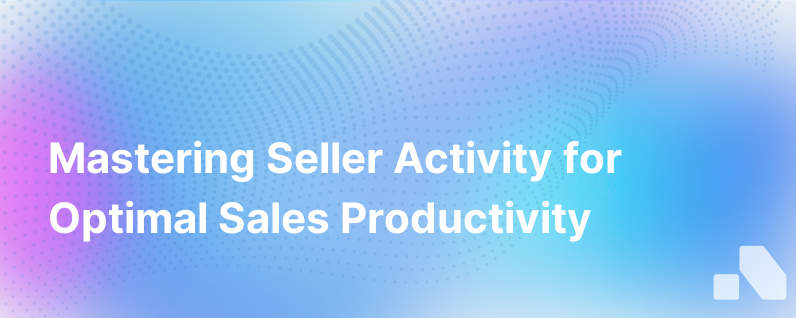
In an environment where B2B sales are increasingly competitive and complex, properly managing seller activity and productivity becomes paramount for any sales organization aiming to thrive. Many factors contribute to the effectiveness and efficiency of a sales team. These include strategic time management, intelligent resource allocation, buyer-focused selling techniques, and leveraging technology to streamline sales processes. While traditional sales metrics still hold value, the modern landscape calls for a nuanced approach to managing seller activity and seller productivity.
Here's a comprehensive guide on how to navigate and manage these critical elements within your sales team.
Understanding Seller Activity
Seller activity encompasses the actions and tasks that sales representatives engage in daily. These activities can range from prospecting calls and email outreaches to sales presentations and negotiations. Keeping tabs on these actions is essential to understanding how sellers spend their time and which activities yield the best results.
However, simply quantity does not ensure success. It's the quality and strategic intent behind these activities that drive true productivity. Quality activity means engaging in high-value tasks that directly contribute to the sales pipeline and revenue goals.
Measuring Seller Productivity
Seller productivity broadly refers to the effectiveness of a seller's activities in terms of achieving sales goals. It's not just about how much a salesperson does, but rather how well they convert their efforts into tangible results. Key performance indicators to consider might include sales cycle duration, conversion rates, average deal size, and revenue generated.
Productivity issues may not just stem from a lack of effort or skill; often, systemic problems like inefficient processes or poor lead quality can hinder a seller's potential. Identifying and resolving these issues can significantly enhance overall productivity.
Strategies for Managing Seller Activity and Productivity
Managing these two components of your sales force involves a range of activities:
1. Setting Clear Expectations and Goals
Start with clear, quantifiable objectives that align with broader business goals. Sellers should understand what targets they're aiming for and how individual activities contribute to the company's success.
2. Structuring Time Effectively
Time-blocking and prioritizing tasks can help sellers focus on high-value activities. Encourage practices like dedicating specific parts of the day to prospecting or following up on leads.
3. Utilizing Sales Automation Tools
Automate repetitive tasks where possible. CRM platforms can help manage customer interactions, while sales automation tools can handle email sequences and lead scoring.
4. Enhancing Training and Development
Invest in ongoing training and professional development. This ensures your team is not only skilled in sales techniques but also adept at using any sales tools at their disposal.
5. Tracking and Analyzing Data
Implement systems that track the right data and provide actionable insights. This step might involve setting up CRM reports, monitoring sales calls, or analyzing email outreach campaigns.
6. Fostering a Culture of Accountability
Create a culture that encourages ownership and accountability. Use one-on-ones and team meetings to discuss progress, celebrate wins, and address challenges.
7. Offering Constructive Feedback
Provide frequent and constructive feedback, helping sellers understand what activities are effective and which need refinement.
8. Aligning Support Resources
Ensure your sellers have the resources they need, from marketing content to product information, so they can focus on selling rather than searching for materials.
9. Streamlining Sales Processes
Regularly review your sales processes for bottlenecks or unnecessary steps that could be slowing down your team.
10. Rewarding High Performance
Incentivize productivity with a compensation plan that rewards outcomes, not just output. This strategy can help motivate sellers to work smarter.
Leveraging Technology for Efficient Management
Modern sales teams have an array of technological solutions at their disposal designed to optimize seller activity and productivity. CRM platforms lie at the heart of managing sales activities, providing a single source of truth for all customer interactions and sales processes.
Advancements in analytics and AI offer deeper insights into which activities drive sales and what behaviors top performers exhibit. Sales engagement platforms can automate outreach and follow-up, ensure messages are personalized and timely, and provide data on what strategies resonate best with prospects.
Finally, tools like Aomni offer streamlined solutions for B2B sales by delivering a blend of real-time account research, competitive insights, and personalized sales content, all aimed at enhancing seller productivity with minimal effort required. Sales technologies like these can unlock new levels of efficiency by taking over the heavy lifting of data gathering and analysis, enabling sellers to focus on what they do best – selling strategically.
Conclusion
Managing seller activity and productivity is multifaceted and requires a deliberate strategy that combines clear expectations, insightful data tracking, and the integration of technology to streamline workflow. By focusing on the quality of activities rather than the quantity, promoting efficient time management, and employing sales automation and AI tools, sales leaders can amplify their team's productivity while nurturing a culture of success.
Equipped with streamlined processes, insightful data, and enabling technologies, your sales team will be better positioned to meet the modern demands of B2B sales and thrive in the competitive market landscape.